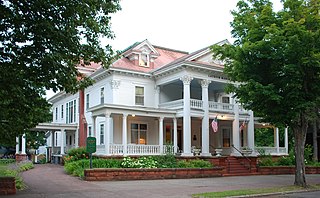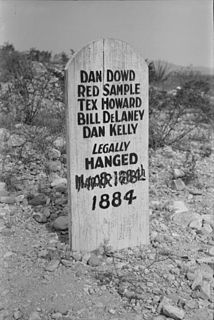
Bisbee is a city and the county seat of Cochise County in southeastern Arizona, United States. It is 92 miles (148 km) southeast of Tucson and 11 miles (18 km) north of the Mexican border. According to the 2010 census, the population of the town was 5,575.

Douglas is a city in Cochise County, Arizona, United States that lies in the north-west to south-east running Sulpher Springs Valley. Douglas has a border crossing with Mexico at Agua Prieta and a history of mining.

Thomas Edward Campbell was the second governor of the state of Arizona, United States. He was the first Republican and first native-born governor elected after Arizona achieved statehood in 1912.

The Bisbee Deportation was the illegal kidnapping and deportation of about 1,300 striking mine workers, their supporters, and citizen bystanders by 2,000 members of a deputized posse, who arrested them beginning on July 12, 1917, in Bisbee, Arizona. The action was orchestrated by Phelps Dodge, the major mining company in the area, which provided lists of workers and others who were to be arrested to the Cochise County sheriff, Harry C. Wheeler. Those arrested were taken to a local baseball park before being loaded onto cattle cars and deported 200 miles (320 km) to Tres Hermanas in New Mexico. The 16-hour journey was through desert without food and with little water. Once unloaded, the deportees, most without money or transportation, were warned against returning to Bisbee. The US government soon brought in members of the US Army to assist with relocating the deportees to Columbus, New Mexico.

Tombstone Courthouse State Historic Park is a state park of Arizona in the United States. Located in Tombstone, the park preserves the original Cochise County courthouse. The two-story building, constructed in 1882 in the Victorian style, is laid out in the shape of a cross and once contained various county offices, including those of the sheriff, recorder, treasurer, and the Board of Supervisors as well as courtrooms and a jail. Inside, the courthouse contains a museum with numerous artifacts from the town's history while outside, a replica gallows has been constructed in the courtyard to mark the spot where seven men were hanged for various crimes. The park was one of the first to be designated as a state park and in 1959 was the first to open following the 1957 establishment of the Arizona State Parks Board.

Harry Cornwall Wheeler was an Arizona lawman who was the third captain of the Arizona Rangers, as well as the sheriff of Cochise County, serving from 1912 into 1918. He is known as the lead figure in the illegal mass kidnapping and deportation of some 1200 miners and family members, many of them immigrants, from Bisbee, Arizona to New Mexico in 1917. Beginning on July 12, 1917, he took total control of the town of Bisbee, controlling access and running kangaroo courts that deported numerous people.

The 4 Lazy F Ranch, also known as the Sun Star Ranch, is a dude ranch and summer residence in Jackson Hole, Wyoming, built by the William Frew family of Pittsburgh in 1927. The existing property was built as a family retreat, not as a cattle ranch, in a rustic style of construction using logs and board-and-batten techniques. The historic district includes seven cabins, a lodge, barn corral and smaller buildings on the west bank of the Snake River north of Moose, Wyoming. The property was added to the National Register of Historic Places in 1990.
The El Paso and Southwestern Railroad began in 1888 as the Arizona and South Eastern Railroad, a short line serving copper mines in southern Arizona. Over the next few decades, it grew into a 1200-mile system that stretched from Tucumcari, New Mexico southward to El Paso, Texas, and westward to Tucson, Arizona, with several branch lines, including one to Nacozari, Mexico. The railroad was bought by the Southern Pacific Railroad in 1924 and fully merged into its parent company in 1955. The EP&SW was a major link in the transcontinental route of the Golden State Limited.

The Thomas H. Hoatson House is a house located at 320 Tamarack Street in Laurium, Michigan. It was listed on the National Register of Historic Places in 1994. At 13,000 square feet (1,200 m2), it is the largest mansion in the western Upper Peninsula of Michigan.

Empire Ranch is a working cattle ranch in southeastern Pima County, Arizona, that was placed on the National Register of Historic Places in 1976. In its heyday, Empire Ranch was one of the largest in Arizona, with a range spanning over 180 square miles, and its owner, Walter L. Vail, was an important figure in the establishment of southern Arizona's cattle industry.

Aztec Land and Cattle Company, Limited ("Aztec") is a land company with a historic presence in Arizona. It was formed in 1884 and incorporated in early 1885 as a cattle ranching operation that purchased 1,000,000 acres in northern Arizona from the Atlantic & Pacific Railroad. It then imported approximately 32,000 head of cattle from Texas and commenced ranching operations in Arizona. Because Aztec's brand was the Hashknife, a saddler's knife used on early day ranches, the company was known more famously as The Hashknife Outfit. The company has been in continuous existence since 1884.

The Bisbee massacre occurred in Bisbee, Arizona, on December 8, 1883, when six outlaws who were part of the Cochise County Cowboys robbed a general store. Believing the general store's safe contained a mining payroll of $7,000, they timed the robbery incorrectly and were only able to steal between $800 to $3,000, along with a gold watch and jewelry. During the robbery, members of the gang killed four people, including a lawman and a pregnant woman. Six men were convicted of the robbery and murders. John Heath, who was accused of organizing the robbery, was tried separately and sentenced to life in prison. The other five men were convicted of murder and sentenced to hang.
Raymond Phillips Sanderson (1908-1987) was an American artist and sculptor.

The Bisbee Group is a geologic group in Arizona, Mexico, and New Mexico. It preserves fossils dating back to the early Cretaceous period.

Round Valley is a census-designated place (CDP) in Gila County, Arizona, United States. The population was 487 at the 2010 census.

Fred Colter was an Arizona rancher and farmer, as well as being the state senator for Apache County beginning with Arizona's second state legislature in 1915. Colter spent six terms in the Arizona Senate. He also led the fight on Arizona's behalf to maintain control over the water from the Colorado River, coining the slogan, "Save the Colorado for Arizona". He was a close ally of the state's first governor, George W. P. Hunt. Prior to his election to the state senate, Colter had served as the state's fair commissioner.
Lazy FPU state leak, also referred to as Lazy FP State Restore or LazyFP, is a security vulnerability affecting Intel Core CPUs. The vulnerability is caused by a combination of flaws in the speculative execution technology present within the affected CPUs and how certain operating systems handle context switching on the floating point unit (FPU). By exploiting this vulnerability, a local process can leak the content of the FPU registers that belong to another process. This vulnerability is related to the Spectre and Meltdown vulnerabilities that were publicly disclosed in January 2018.













